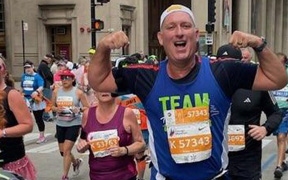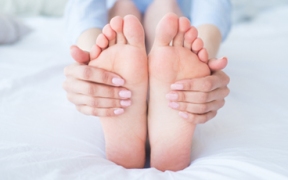What would it be like to lose your foot? Not many people have contemplated this on the deep level that Dave did when he realized he had Charcot foot syndrome. This serious condition can have devastating consequences, including deformity, infection, and even amputation. Dave struggled with his diabetes for years, which led to his foot deteriorating and breaking.
Read on to see how Dave got the foot care he needed for Charcot foot syndrome at IBJI.
A History of Diabetes Leading to Charcot Foot Syndrome
Dave, 62, was diagnosed with diabetes more than 10 years ago. He was over 300 pounds and had been experiencing the classic symptoms of diabetic foot, including neuropathy. At this point, he didn’t have any idea that he would develop Charcot foot syndrome.

Dave and his wife Cathy have been eating healthier to get Dave's diabetes under control.
What Led to Dave’s Charcot Foot Syndrome
Three years ago, Dave was working in his backyard. He has a one-and-a-half-acre property on the Fox River, and he is an avid outdoorsman who enjoys caring for his trees and land.
“I stepped on a nail because I was wearing crocs and not work boots,” Dave recalls. “I got an infection in my foot because I didn’t clean it right away and I kept working.”
A few days later, his foot – which was not the foot that would later develop into Charcot foot syndrome – turned bright red. Dave then developed a fever.
That’s when he was admitted to the hospital and was seen by Steven Jasonowicz, DPM, a podiatric foot and ankle surgeon with IBJI.
“Unfortunately, it is all too common that diabetics will present to the hospital with bad foot infections,” Dr. Jasonowicz says. “Neuropathy can make it difficult to tell when an infection is setting in and often by the time a patient realizes what is going on, the infection has become quite severe as in Dave’s case.”
Dave’s First Surgery Before Charcot Foot Syndrome Diagnosis
“Dr. J did the surgery, cleaned it out, and stitched it up to take care of the wound,” Dave recalls. “I had three months of intravenous IVs that I had to do myself at home.”
Dave realized that he had just recovered from a very bad infection. It was enough to scare him and get him thinking about his diabetes. He didn’t yet develop Charcot foot syndrome, but he began to contemplate his diabetes and vowed to take better care of his feet.
“The one thing that changed was that I wear shoes in the yard all the time,” Dave says. “I could have lost my foot right there.”
Charcot Foot Syndrome: Dave’s Second Event
Last summer, Dave was outdoors again, enjoying his property. Having 176 feet of shoreline, he often walks among the jagged rocks to cut down tall weeds.
“All of a sudden, I fell over,” Dave says. “What really happened at that moment, although I didn’t know it at the time, was that I broke my foot.”
Diabetic neuropathy prevented Dave from feeling that he’d broken his foot. So he and his wife then embarked on a vacation to the Lake of the Ozarks. While he was boating all day, he noticed that his foot was swollen. By the end of the vacation, he could barely get his foot in his shoe.
“I came back from the vacation and saw Dr. J who said I was in crisis,” Dave says. “He said I had Charcot foot syndrome.”
Diagnosing and Treating Charcot Foot Syndrome
Dr. Jasonowicz took X-rays that revealed the collapse of the bones inside of Dave’s foot. With any diabetic that develops a red swollen foot, Charcot foot syndrome needs to be a consideration, says Jasonowicz.
“Although these symptoms can be seen with other injuries, Charcot foot needs to be ruled out,” he says. “If caught early, a Charcot foot is much easier to treat rather than in the late stages when collapse of the foot, deformity, ulceration, and other complications may have already occurred.”
MRI Scan to Confirm Charcot Foot Syndrome
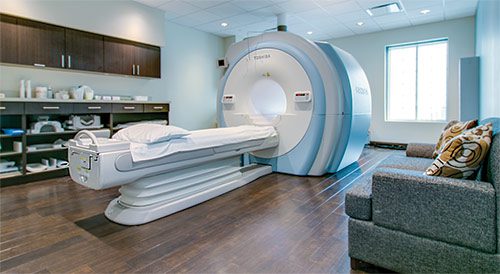
An MRI scan can help reveal Charcot foot syndrome.
Dr. Jasonowicz ordered an MRI scan, which further supported the diagnosis of Charcot foot syndrome. This diagnosis opened up a conversation with Dave about the various treatment options.
“The foot definitely needed to be immobilized and offloaded to prevent further damage,” Dr. Jasonowicz explained. “In Dave’s situation, we chose to use an external fixator, a device that uses pins and wires attached to an external frame that holds the bones in the correct position.”
Treatment Approach for Charcot Foot Syndrome
Dr. Jasonowicz says that this particular approach for Charcot foot syndrome can be challenging for the patient, but it helps to ensure one of the best outcomes.
“Using an external fixator helps to ensure the bones aren’t going to go anywhere because they are held in place by the device,” he explains. “The patient can’t take it off, so the compliance is much higher than a boot or cast.”
Weighing Charcot Foot Syndrome Treatment Options
After hearing about the external fixator recommended to treat his Charcot foot syndrome, Dave now had a decision to make. Would he choose to immobilize his foot with a boot or would he have the external fixator put on?
Installing the External Fixator for Charcot Foot Syndrome
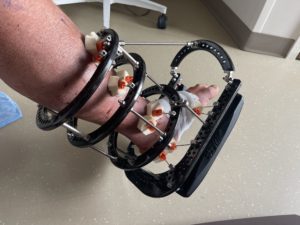
Dave wore an external fixator for his Charcot foot syndrome to keep his foot immobilized.
Dave chose to go the route of having the external fixator put on to treat his Charcot foot syndrome. During the surgery, Dr. Jasonowicz not only placed the device on but also took biopsies of multiple areas of bone to help support the diagnosis of Charcot foot syndrome and further rule out any infection.
After having the external fixator placed, Dave saw the gravity of his diabetes for the first time. He would have to heal for months with an immobilized foot. The fishing, boating, and jet skiing he had always enjoyed would have to be put on hold. He wouldn’t be able to walk on his property for a long time.
“You don’t really realize what diabetes is doing to you,” he says. “I almost lost my foot. I credit Dr. J for scaring me and making me do the right thing, which is getting my diabetes under control.”
The Long Wait to Heal from Charcot Foot Syndrome
Thankfully, Dave’s wife Cathy is a former surgical nurse and was a great support while Dave was healing from Charcot foot syndrome. She kept a close eye on his foot and encouraged Dave along the way to get his blood sugar level – A1C – under control.
His primary doctor prescribed a medicine for diabetics that aids in weight loss, and Cathy shopped for healthy foods.
“What I would normally do is take a bag of potato chips and eat the whole bag,” Dave says. “That was my nightly event with carbs.”
Cathy, who also wanted to lose weight, learned about keto diets, and Dave says he was then “dragged kicking and screaming” into healthier eating.
“We used to eat a lot of boxed things with tons of salt and carbs,” Dave says. “Now we’re practicing limiting our carbs.”
Dave Loses Weight to Address His Charcot Foot Syndrome
For as long as Dave can remember, he says, he has “loved food more than life.” But the medication his doctor prescribed started working right away, and it changed everything.
“I couldn’t exercise or work in the yard, yet I was losing weight at a frantic pace,” he says, adding that he had to be reminded to eat. “On December 6, 2020, I was 306 pounds. When I went for my physical at the end of October 2021 I was at 275. Since then, I’ve lost another eight pounds. My goal is 200 pounds.”

Dave has lost a considerable amount of weight after suffering from Charcot foot syndrome.
A1C Levels and Charcot Foot Syndrome
One of Dave’s greatest achievements is boasting about his blood sugar level, which used to be 8.2. This is what really caused the Charcot foot syndrome issue.
“I’ve got it down to 5.7 and I’m well on my way to a better life,” Dave says.
Transitioning to a Cast for Charcot Foot Syndrome
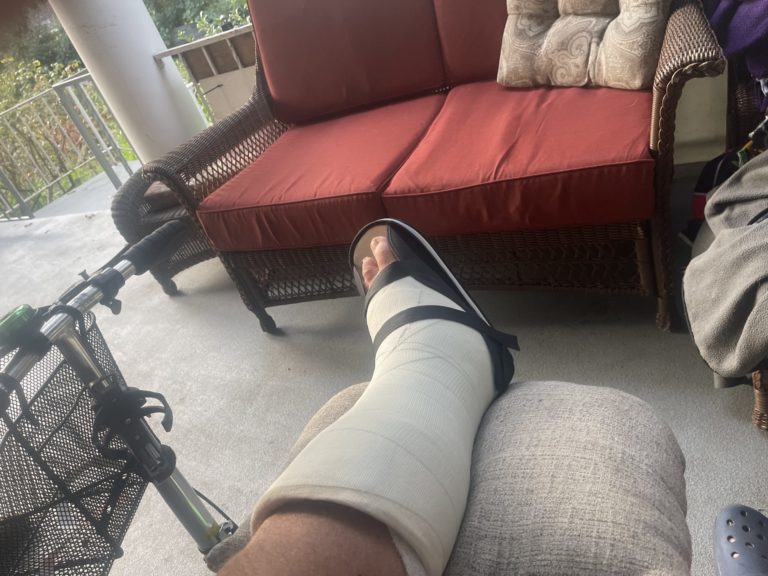
Dave transitioned to a cast to continue healing from Charcot foot syndrome.
In October 2021, Dave’s external fixator was taken off and he was put into a walking cast to continue to protect and heal his Charcot foot syndrome.
“I went a month with the walking cast and then he took that off and put me in a boot,” Dave says. “I wore that for about two months.”
Returning to a Normal Life After Charcot Foot Syndrome
Now that he has gotten back to being mobile, Dave rides a Schwinn Airdyne bike to build back muscle and continue his weight loss. He’s also working toward healing other health issues, like sleep apnea. In order not to return to poor eating habits, Dave has a daily reminder.
“The apparatus is sitting on top of the refrigerator so when I go to eat, it reminds me to stay on track,” he says. “What I went through was a nightmare and losing my foot would have been the biggest disaster.”
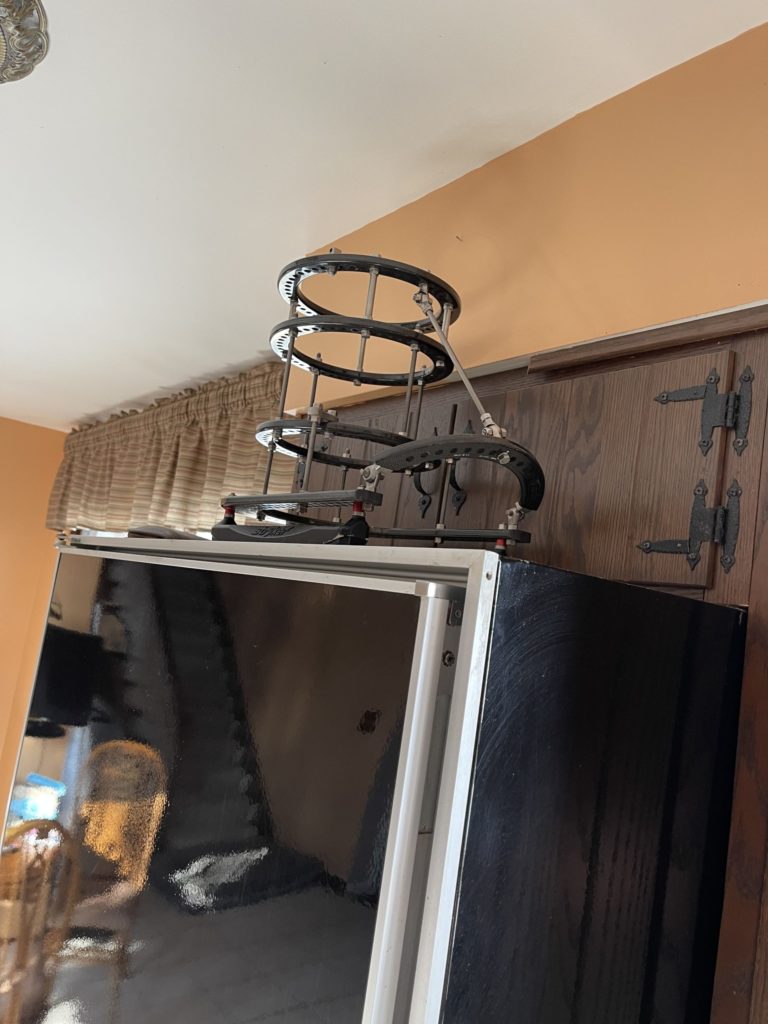
Dave placed the apparatus for his Charcot foot syndrome on top of the refrigerator to remind himself to make healthy food choices.
Encouraging Others Who May Develop Charcot Foot Syndrome
Dave has a friend who is experiencing uncontrolled diabetes and he shares his story to hopefully prevent Charcot foot syndrome from happening to others.
“If I can help somebody understand what they’re doing to themselves, it’s well worth it,” he says. “I don’t want anybody to go through Charcot foot syndrome.”
Lessons Learned After Charcot Foot Syndrome
One of the biggest takeaways for Dave after going through a serious Charcot foot syndrome issue is that patients shouldn’t just hear what their doctors are saying, they should actively listen and follow their advice.
“I am listening much more to the people who are experts because I know they have my best interests at heart,” Dave says.
Appreciating the IBJI Care That Cured His Charcot Foot Syndrome
Calling Dr. “J” a lifesaver, Dave says he feels like his recovery was nothing short of miraculous. It helped that Dr. Jasonowicz studied under surgeons who have been doing this type of surgery for years.
“Dr. J did a great job with me, as I’m sure he does with everyone else,” Dave says.
“To me, it’s most impressive to see how he has taken this as an opportunity to get his diabetes under control,” Dr. Jasonowicz adds. “He used this experience as an opportunity to change his life.”
Great Podiatric Care at IBJI
Whether you have diabetes or not, caring for your feet is important. Get more information about foot and ankle care at IBJI to get back to feeling your best.



